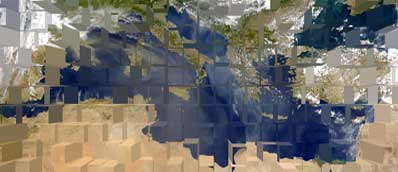
Funded by
European Commission
V Framework Program Energy, Environment and Sustainable Development |
ATMOSPHERIC FORCING AND AIR-SEA INTERACTION
STUDIES - WORKPACKAGE
10 |
 |
|||
|
|||
|
|||
|
|
|||||
WP10-Atmospheric forcing and air-sea interaction studies
Task 10100 NRT
atmospheric forcing for ocean forecasts This Task contains the necessary activities to deliver the
atmospheric surface fields to the WP8 and WP9 ocean modelling community. In
addition it defines the experimental strategy for the SVP inter-comparison
exercise. Subtask 10130 Preparation of LAM for the Eastern Mediterranean Responsible: IASA Duration: 9 months (T0-T9) Deliverables : LAM2 model implemented in the eastern Mediterranean area (Milestone T0+9) (D04) Subtask 10140 NRT LAM forcing dissemination for TOP forecasts Responsible: MF Partners: MF, IASA, CHMI Duration: 15 months (T9-T24) Deliverables: NRT LAM surface data for forecasting (Milestone T0+9) (D05) Subtask 10150 LAM fields for validation studies in SVP Responsible: IASA Partners: IASA, MF, CHMI Duration: 3 months (T6-T12) Deliverables: Definition of the intercomparison protocol and set of selected meteorological conditions (milestone T0+6), corresponding LAM full volume atmospheric data archive for validation studies (Milestone T0+12). (D06) (D07) Subtask 10160 Web server facility Responsible: IASA Partners: MF, CHMI Duration: 6 months (T0-T6) Deliverables: LAM surface data exchange protocols (Milestone T0+6) (D08) Task 10200
Sensitivity of atmospheric response to sea surface parameters. The
atmospheric response to sea state conditions and especially to SST
spatio-temporal variability is considered important for several Mediterranean
areas. SST variability can affect significantly the mesoscale flow
characteristics by generating/modifying local thermal circulations. The most
important influence is in the water budget of the nearby land. As it has been
pointed out in WP10-ref.04,
WP10-ref.05, WP10-ref.06,
one degree C SST difference can create an increase/decrease by 5-7% in the
amount of water received over the nearby land and therefore influence the
flooding conditions. The upwelling/downwelling areas of the Mediterranean Basin
are known as well as other formations (e.g. Ierapetra gyre) where strong
temperature gradients are formed during the period of the year. These
formations can modify substantially atmospheric systems especially these
associated with severe weather. In
addition, it is well known that in the Mediterranean there are cyclonic
formations with the characteristics of hurricanes (“eye” formation, strong
cyclonic wins etc, WP9-ref.06). These systems are strengthening
in areas with warm waters and especially in areas with sharp SST gradients. Subtask 10210. Usage of high-resolution SST in atmospheric model initialisation. Responsible: IASA Partners: IASA, UAT Duration: 9 months
(T9-T18) Deliverables : Atmospheric
simulations with high resolution SST. Milestone T0+18. (D09) Subtask 10220 Usage of model predicted SST fields fron the ALERMO model Responsible: IASA Participants: IASA, UAT Duration: T24-T32 (8 months) Deliverables : LAM2 simulations with predicted SST. Milestone
T0+32 (D10) Task 10300 Study
of air-sea interactions physical parameterizations on the atmospheric processes Numerical weather predictions are sensitive to surface fluxes of heat, momentum and moisture. The aim of this task is to explore the role of the sea surface fluxes in formation and evolution of characteristic weather regimes. Forecasted sea surface parameters produced within WP9 will be used for calculation of moisture, heat and momentum gained/lost by the atmosphere within each time step of numerical simulations on selected cases. Subtask 10310 Development of sea surface submodels Responsible: IASA Participants: IASA, ICOD Duration: T0-T24 (24 months) Deliverables: Studies of atmospheric response with sea surface submodels, compared with control run (Milestone T0+24) (D11) Task 10400 Implementation
of higher resolution LAM in Mediterranean sub-regions It is well known that small-scale flow patterns or severe weather in the atmosphere require non-hydrostatic atmospheric models. Basic reasons for this are that significant differences between hydrostatic and thermal pressures exist, which produce non-negligible vertical accelerations. On the other hand, the ocean circulation in the shelf areas could be sensitive to details of the atmospheric flow field that are non-hydrostatic since their horizontal scale will be comparable to the scale height of the atmosphere (10 km). Subtask 10410 Aegean and Levantine region Responsible:IASA Duration: T28-T36 (8 months) Deliverables: One-month forecasts of the sea surface fluxes for the ALERMO area (Milestone T0+36) (D13) Task 10500.
Evaluation of the regional scale atmospheric models during SVP The various model results produced during the SVP-WP10 and other related hindcasting operations will be validated against observations from various sources. The data sources are described in WP1 and WP2. This task is subdivided in two subtasks as follows. Subtask 10510 Evaluation of the model results produced during the SVP (Basin and shelf areas of various resolutions). Responsible: IASA Partners: IASA, ICOD Duration: T13-T36 (24 months) Deliverables : Skill scores for the various models and their configuration (Milestone T0+36) (D16) Subtask 10520 Evaluation of the sea-surface winds based on wave parameters (calculated by using the atmospheric model winds) and wave observations Responsible: IOLR Partners involved:
IASA, UAT, NCMR, UPC, MF Duration: 30 months (T6-T36) Deliverables: Report describing the evaluation procedures
followed and the scores. (D17) |
|||||
|
|||||